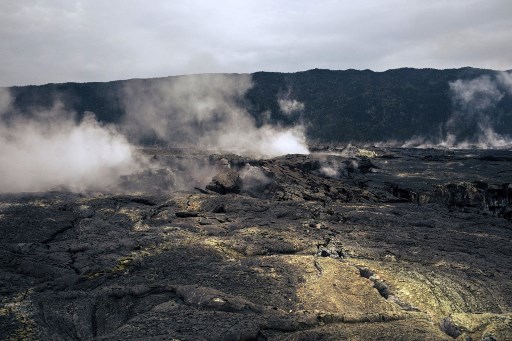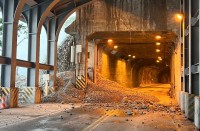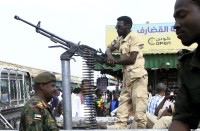
by Alexis Huguet
GOMA, DR Congo (AFP) — The situation is “under control” following the eruption of a volcano in the Democratic Republic of Congo, President Felix Tshisekedi said on Saturday after his government mistakenly announced another volcano had erupted.
A week after Mount Nyiragongo roared back into life, causing devastation and sparking a mass exodus, “the situation is certainly serious but it is under control,” Tshisekedi told a news conference.
Around 400,000 residents have evacuated the eastern city of Goma after a week of rolling aftershocks following the eruption of Africa’s most active volcano.
“There is an underground lava flow that can arise anytime anywhere in the city,” Tshisekedi warned, strongly advising against people returning to Goma.
“The lava is no longer in the crater, but the volcano remains active, so we have to be wary and that’s why we don’t want to rush things by bringing back the populations,” he said.
His comments came after more than 1,000 refugees left a camp in Rwanda to return to DR Congo on Saturday.
Earlier in the day the DRC’s government announced that another volcano had erupted, later admitting it was a false alarm,
The blunder comes as the government is increasingly criticised over a looming humanitarian crisis.
“A plane has just flown over the entire area on the sides of this volcano. No eruption was observed,” it added.
The Goma Volcano Observatory (OVG) confirmed that while there was “intense activity” at Nyamuragira, “there has been no eruption”.
‘Limnic eruption’ fears
Goma, the capital of North Kivu province, lies on the shores of Lake Kivu in the shadow of Nyiragongo, Africa’s most active volcano.
Last Saturday the strato-volcano spewed rivers of lava that claimed nearly three dozen lives and destroyed the homes of 20,000 people before the eruption stopped.
Hundreds of aftershocks have rocked the region since, but the OVG said Saturday they had significantly decreased in both number and intensity over the past 48 hours.
The OVG’s latest report said that 61 earthquakes had shaken the area in the previous 24 hours.
It said the quakes were “consistent with the continued movement of magma in the Nyiragongo fissure system towards Lake Kivu”.
Scientists have warned of a potentially catastrophic scenario — a “limnic eruption” which occurs when lava combines with a deep lake and spews out lethal gas across a potentially large area.
However the OVG report said a “landslide or large earthquake destabilising the deep waters of the lake causing the emergence of dissolved gases” was now much less likely, though it still “cannot be excluded”.
Around 80,000 households — 400,000 inhabitants — have moved out of Goma since Thursday, when a “preventative” evacuation order was given.
‘I have nothing left’
Around 3,000 people fleeing Goma sought refuge at a temporary camp in Rugerero, about 10 kilometres (six miles) over the Rwandan border.
But on Saturday an estimated 1,200 had left to return to Goma, a Rwanda government official at Rugerero told AFP on condition of anonymity. Military trucks were seen transporting refugees to the border.
William Byukusenge, a construction worker, told AFP that “if it erupts again, we will come back to Rwanda”.
But another evacuee, Marie Claire Uwineza, said she had nowhere left to go.
“My house was burned, and I have nothing left,” said the 39-year-old, who fled with two of her children.
Criticism has been growing over the government response after Thursday’s evacuation order was met with fear and traffic jams, many not knowing where to go.
“The population had the impression of being abandoned to their sad fate,” said the newspaper EcoNews, calling it “a perfect illustration of the fact that the state does not exist”.
Prime Minister Jean-Michel Sama Lukonde defended the government’s response, saying the event had “no similarity to previous eruptions in that it occurred without warning signs”.
The mounting humanitarian crisis comes in a region that has been ravaged by violence for three decades. Access to drinkable water is particularly urgent, according to aid organisations in the area.
“Sometimes it’s the war, now it’s the volcano,” a customs officers grumbled Saturday.
President Tshisekedi said the authorities were “on the way” to being able to distribute drinking water to those who had fled the area, adding that 5,000 houses had been destroyed.
© Agence France-Presse






